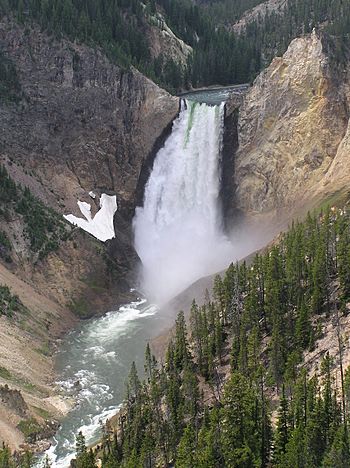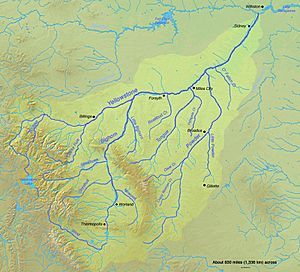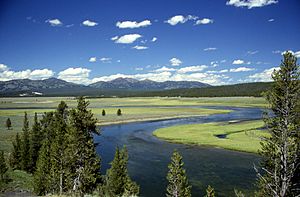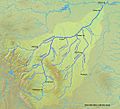Yellowstone River facts for kids
Quick facts for kids Yellowstone River |
|
|---|---|

Yellowstone Falls on the Yellowstone River in Yellowstone National Park
|
|

Map of the Yellowstone River watershed
|
|
| Country | United States |
| State | Wyoming, Montana, North Dakota |
| Physical characteristics | |
| Main source | Confluence of North and South Forks Absaroka Range, Wyoming 43°59′18″N 109°55′45″W / 43.98833°N 109.92917°W |
| River mouth | Missouri River McKenzie County, near Buford, North Dakota 47°58′42″N 103°58′56″W / 47.97833°N 103.98222°W |
| Length | 692 mi (1,114 km) |
| Basin features | |
| Basin size | 70,000 sq mi (180,000 km2) |
| Tributaries |
|
The Yellowstone River is a long river in the northwestern United States. It is a tributary (a smaller river that flows into a larger one) of the Missouri River. The Yellowstone River flows through three states: Wyoming, Montana, and North Dakota. It also runs through Yellowstone National Park and helps fill Yellowstone Lake.
Many people believe the river's name comes from a Native American name, Mi tse a-da-zi, which means "Yellow Rock River." This name was given by the Minnetaree Indian people. Some stories say the name came from the yellow rocks found along the Grand Canyon of the Yellowstone. However, the Minnetaree people did not live near the upper parts of the Yellowstone River. Other experts think the name came from yellow-colored sandstone cliffs found along the lower parts of the river.
The Yellowstone River was first explored by William Clark in 1806. This happened during the return journey of the famous Lewis and Clark Expedition.
Contents
Exploring the Yellowstone River
In 1873, a pioneer steamboat captain named Grant Marsh explored much of the Yellowstone Valley. He was chosen by the Army for an expedition on his riverboat, the Key West. Marsh carefully wrote down details during his journey. The names he gave to many natural places were recorded and put on official maps.
Yellowstone River's Journey
The main part of the Yellowstone River is over 700 miles (1,100 km) long. It starts in northwestern Wyoming in the Absaroka Range. The river begins where two smaller streams, the North Fork and the South Fork, join together. The North Fork comes from Younts Peak, and the South Fork flows from Thorofare Mountain.
The Yellowstone River flows north through Yellowstone National Park. It fills and then drains Yellowstone Lake. After the lake, it drops over the Upper and Lower Yellowstone Falls. These waterfalls are at the start of the Grand Canyon of the Yellowstone inside the park.
After leaving the park, the river flows north into Montana. It passes through Paradise Valley between two mountain ranges. The river then leaves the mountains near Livingston. From there, it turns east and northeast, flowing across the northern Great Plains. It passes by the city of Billings.
Further east, other rivers join the Yellowstone. The Bighorn River joins it east of Billings. The Tongue River joins near Miles City. Finally, the Powder River joins in eastern Montana. The Yellowstone River then flows into the Missouri River near Buford, North Dakota. This area is just upstream from Lake Sakakawea.
Yellowstone River Basin
The Yellowstone River basin is a large area of land where all the water drains into the Yellowstone River. This basin covers about 37,167 square miles (96,260 km2). Most of it is in Montana, with smaller parts in Wyoming and North Dakota.
The Yellowstone Basin includes the Yellowstone River itself and four main tributary basins:
- The Clarks Fork Yellowstone
- The Wind River and Bighorn River
- The Tongue River
- The Powder River
All these rivers eventually flow into the Missouri River.
At its highest points, the Yellowstone River basin is over 12,800 feet (3,900 m) above sea level. It then drops to 1,850 feet (560 m) where it meets the Missouri River. The basin has many lakes, including Yellowstone Lake.
There are no large dams on the main Yellowstone River itself. However, there are five major reservoirs (human-made lakes) on its tributary rivers. These include Bull Lake, Boysen, Buffalo Bill, Big Horn, Tongue River, and Lake De Smet reservoirs.
River Uses and Environment
The Yellowstone River's waters have been used for irrigation (watering crops) in Montana since the 1860s. This helps farms grow food.
In the upper parts of the river, especially within Yellowstone Park and the mountains of Montana, it's a very popular place for fly fishing. People enjoy catching fish there. The Yellowstone is considered a "Class I river" for recreation. This means people can easily access it for fun activities like fishing.
Sometimes, things like oil can accidentally get into the river. This can harm the water and the animals living there.
Water Levels and Weather
The Yellowstone River watershed can experience flooding. This happens because of melting snow, heavy rainfall, and strong thunderstorms. In higher areas, snow melting quickly in spring and early summer can cause floods. In lower areas, big rainstorms and thunderstorms can cause floods in summer and fall.
The Yellowstone Watershed has also had long periods of very dry weather, called droughts. These droughts can last for several years. When there's a drought, the river's flow decreases. This can lead to more dissolved solids (minerals and other substances) in the water.
Water quality can change along the river. In mountainous areas, the water is usually clearer with fewer suspended sediments and dissolved solids. In flatter areas, human activities like agriculture and mining, along with natural sources, can add more sediment to the water. Some parts of the river also have issues with certain types of bacteria, salt, and selenium.
Fishing in the Yellowstone River
The Yellowstone River is known as one of the best places in the world to catch trout. The best fishing spot is often considered to be through Paradise Valley in Montana, especially near Livingston. Here, you can find different types of trout, including brown, rainbow, and native Yellowstone cutthroat trout. You can also catch mountain whitefish.
Further downstream, from Billings to the North Dakota border, anglers (people who fish) look for other types of fish. These include burbot, channel catfish, paddlefish, sauger, smallmouth bass, and walleye. An endangered species called the pallid sturgeon is also found in the Yellowstone River. This fish lives only in the waters of the Missouri River and lower Mississippi River basins.
Images for kids
See also
 In Spanish: Río Yellowstone para niños
In Spanish: Río Yellowstone para niños




